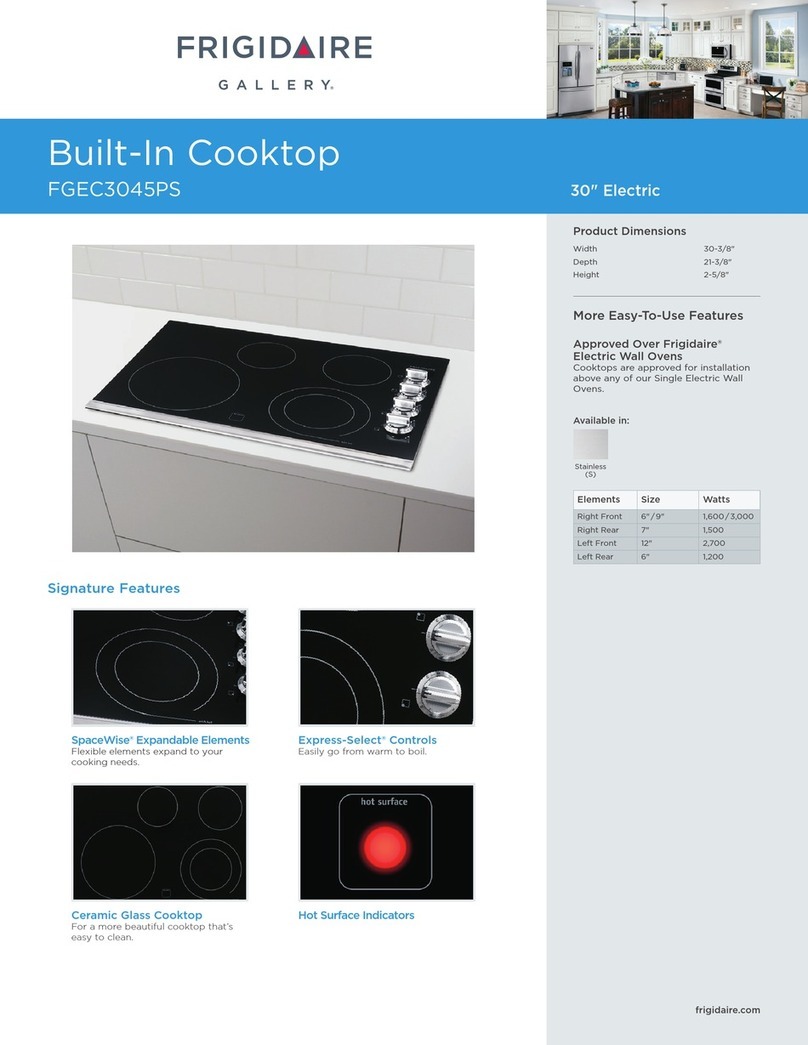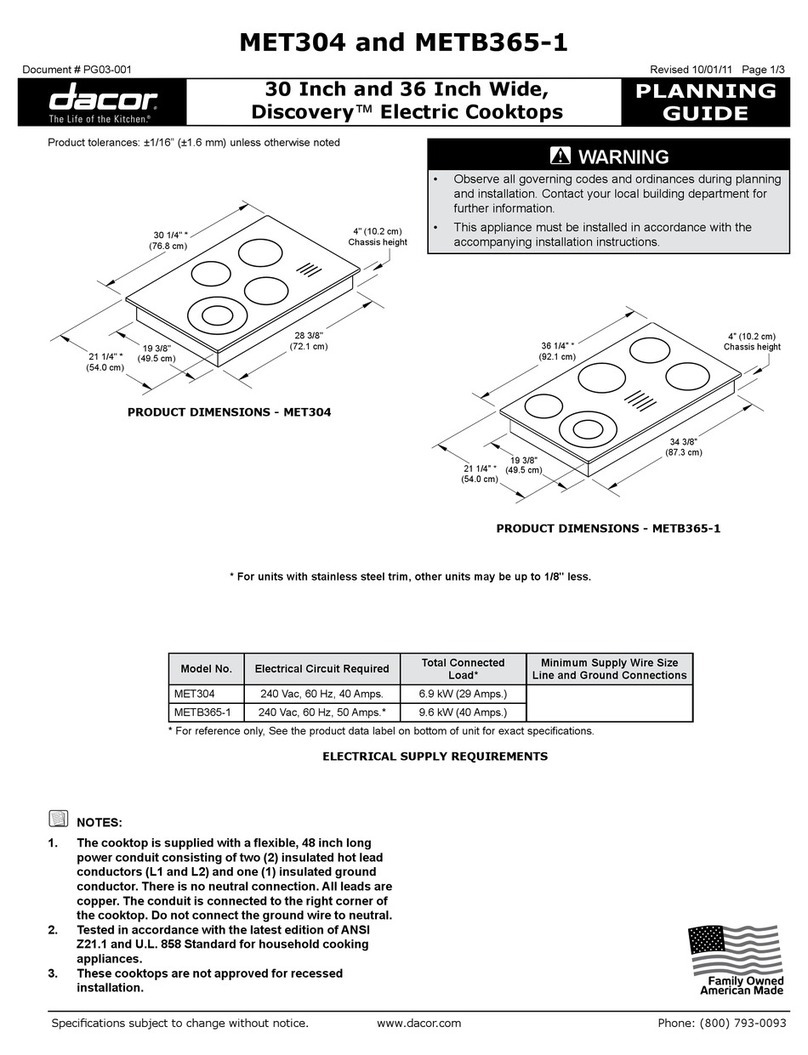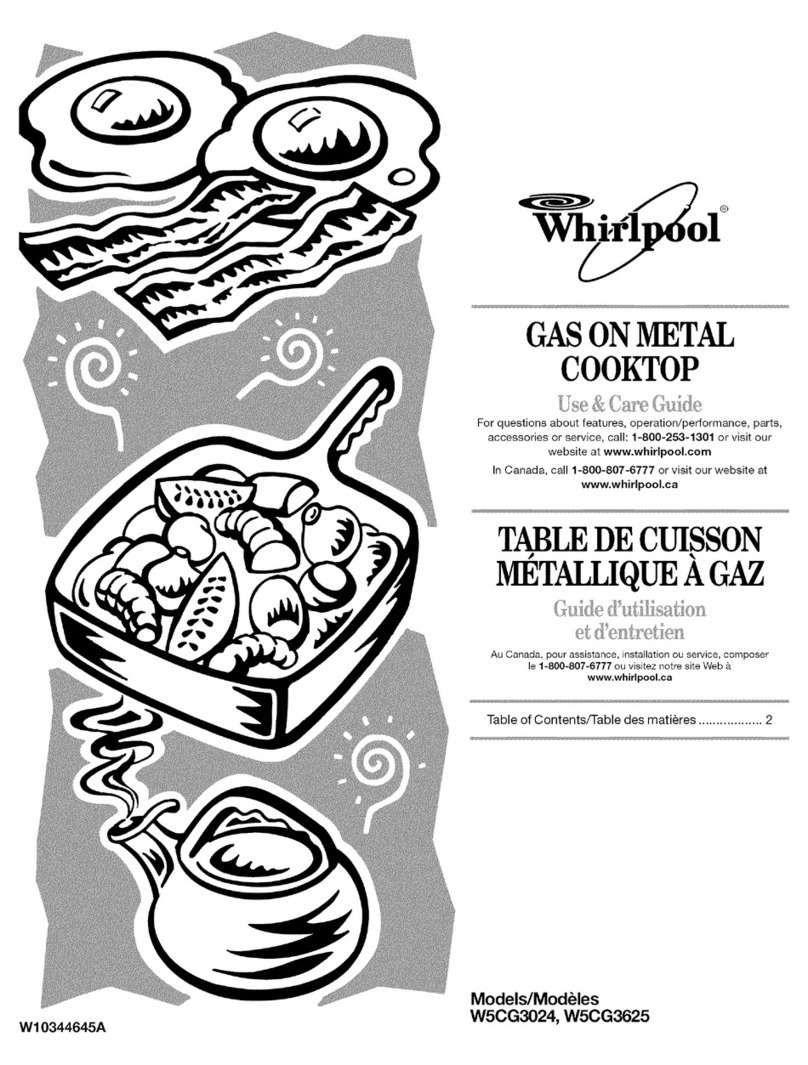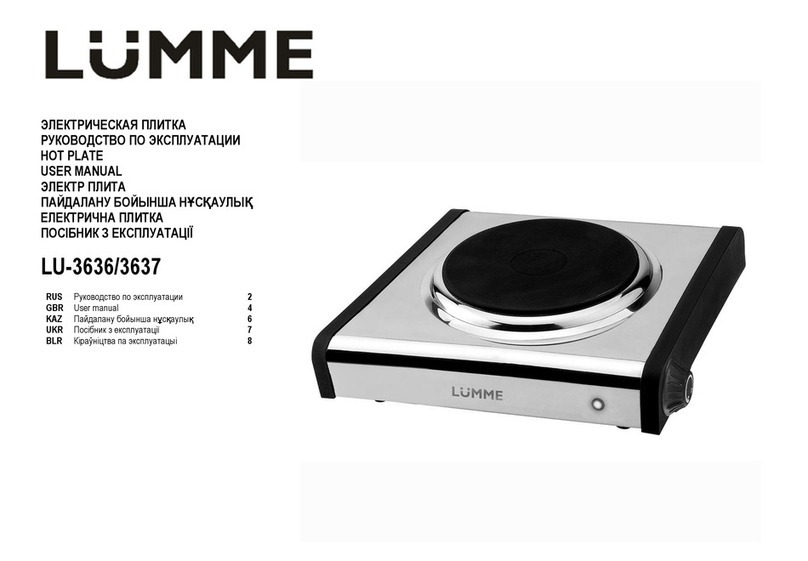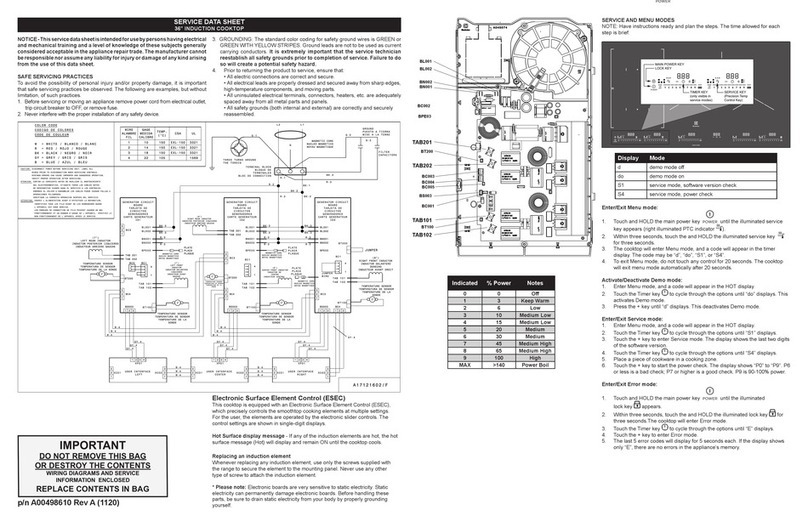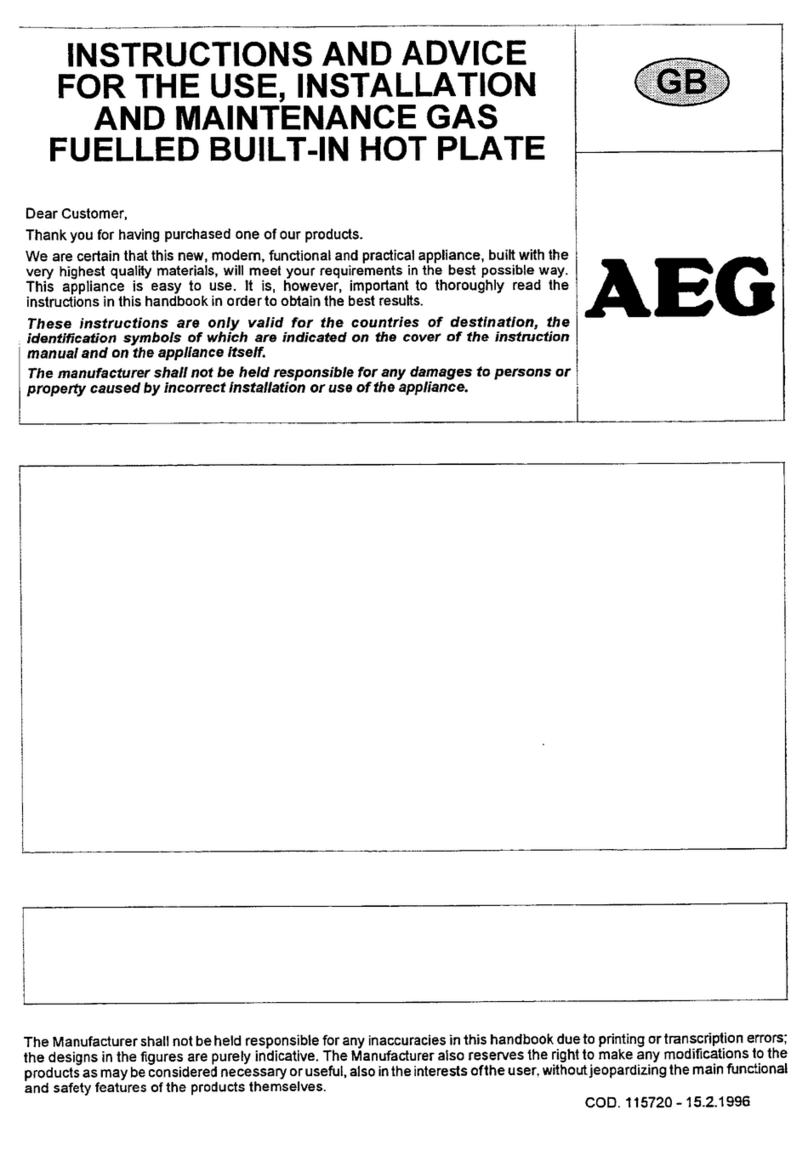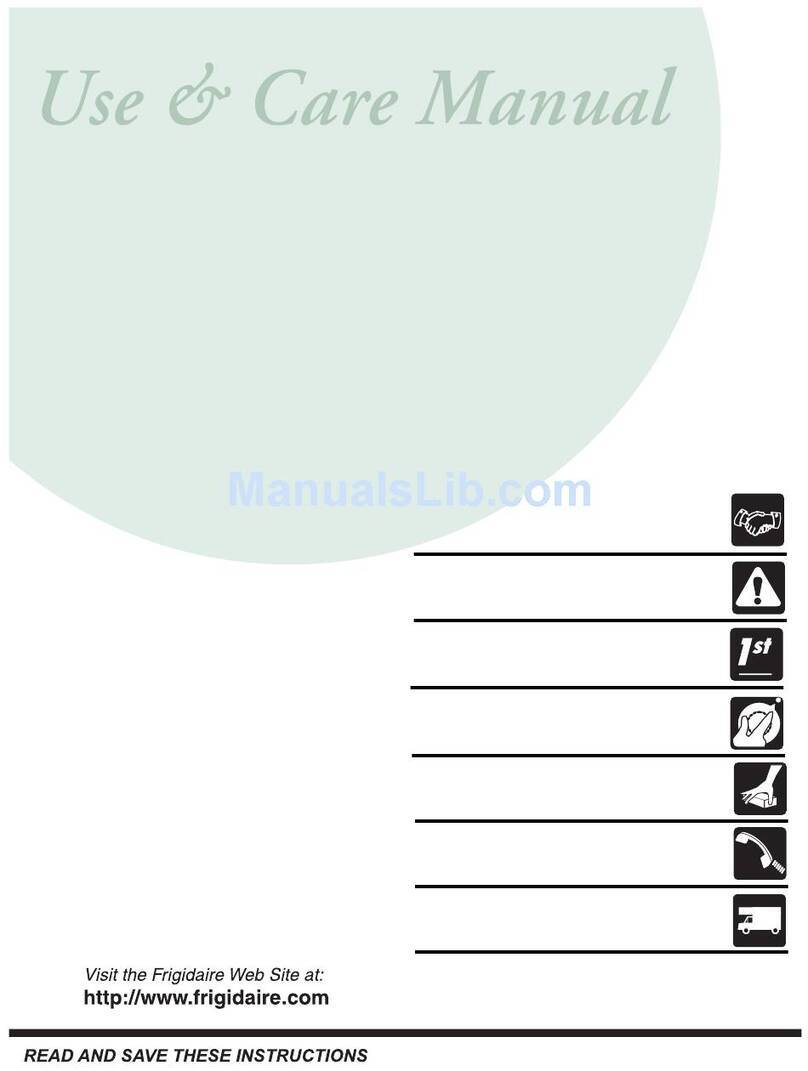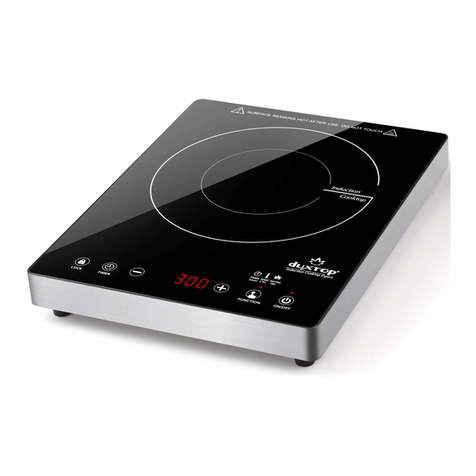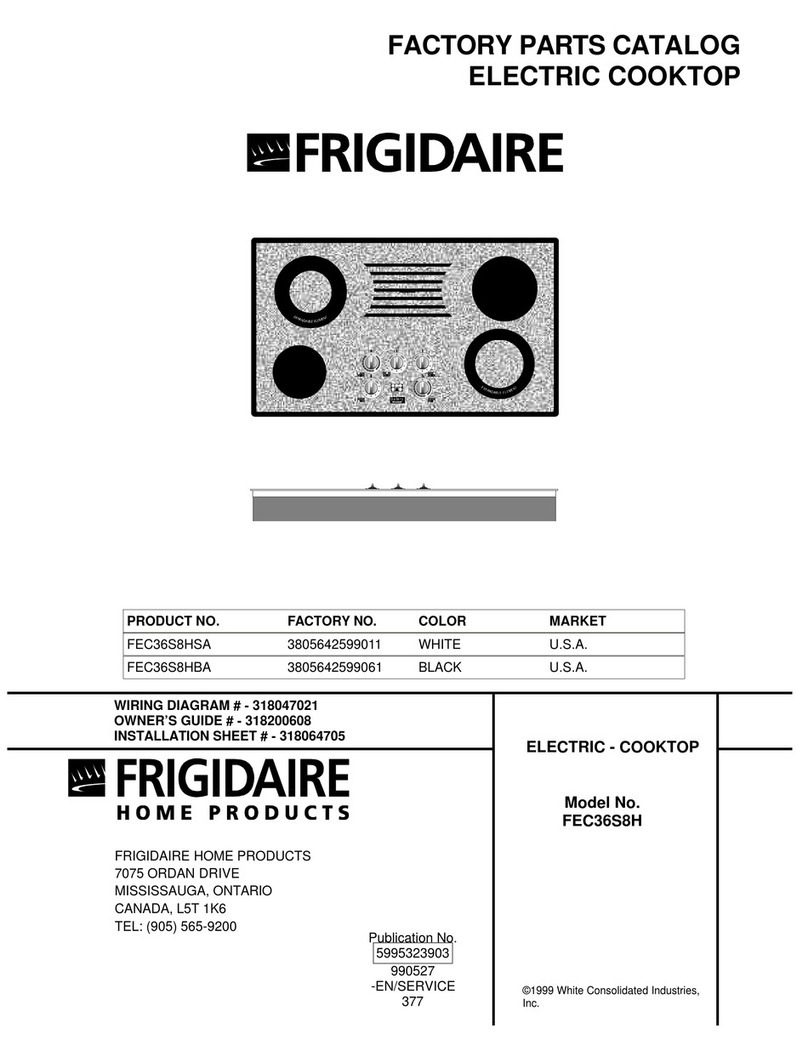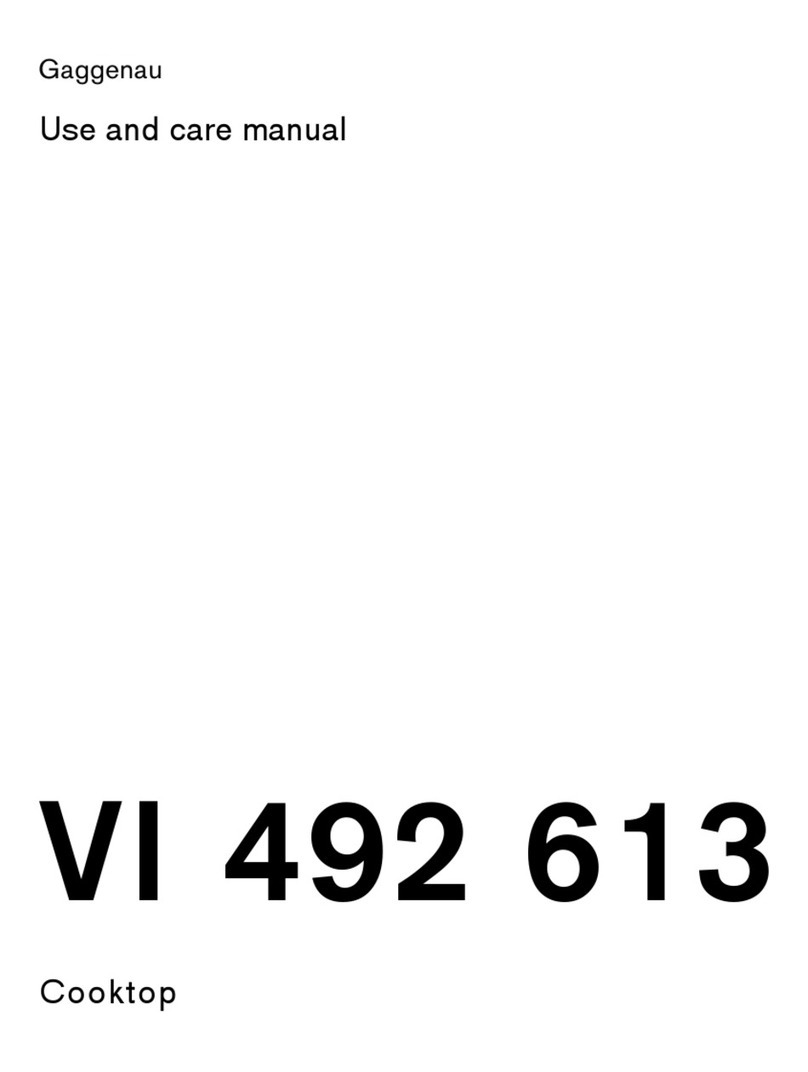elvita CIS5623V User manual

USER MANUAL
INDUCTION COOKER
Before using this product, please read the user manual carefully.
Save the user manual for future reference.
MOD NR: CIS5623V
CIS5623X

EN 1
We thank you for your
trust and the purchase of our appliance.
This detailed instruction manual is supplied to
make the use of this product easier. The
instructions should allow you to learn about your
new appliance as quickly as possible.
Make sure you have received an undamaged
appliance. If you do find transport damage,
please contact the seller from which you
purchased the appliance, or the regional
warehouse from which it was supplied.
Important information
Tip, note
Elon Group AB
Bäcklundavägen 1
702 03 Örebro
Sweden

EN 2
IMPORTANT SAFETY INSTRUCTIONS
CAREFULLY READ THE INSTRUCTIONS AND SAVE THEM FOR
FUTURE REFERENCE.
This appliance may only be used by children aged 8 years and above
and persons with reduced physical, sensory or mental capabilities or
lack of experience and knowledge if supervision or instructions are
provided to them concerning use of the appliance in a safe way and
if they understand the hazards involved. Do not let the children play
with the appliance. Cleaning and user maintenance shall not be made
by children without supervision.
WARNING: The appliance and some of its accessible parts may
become very hot during use. Be careful not to touch the heating parts
of the appliance. Children younger than 8 years of age shall be kept
away unless continuously supervised.
WARNING: The accessible parts of the appliance may become hot
during use. Young children should be kept away from the oven.
WARNING: Danger of fire: do not store items on the cooking
surfaces.
WARNING: Unattended cooking on a hob with fat or oil can be
dangerous and may result in fire. NEVER try to extinguish a fire with
water, but switch off the appliance and then cover flame e.g. with a
lid or a fire proof blanket.
Only use the temperature probe recommended for use in this oven.
CAUTION: The cooking process and a short term cooking process
has to be supervised continuously.
WARNING: If the surface is cracked, switch off the appliance to avoid
the possibility of electric shock.

EN 3
CAUTION: possibility of tilting.
WARNING: In order to prevent tipping of
the appliance, stabilising means must be
installed. Refer to the instructions for
installation.
WARNING: Before replacing the light bulb, make sure the appliance
has been disconnected from the mains power, in order to prevent the
hazard of an electric shock.
Do not place objects like knives, forks, spoons, or lids on the induction
cooking zone as they can become very hot.
Appliance must not be installed behind a decorative door in order to
avoid overheating.
Do not use harsh abrasive cleaners or sharp metal scrapers to clean
the oven door glass/ the glass of hinged lids of the hob (as
appropriate), since they can scratch the surface, which may result in
shattering of the glass.
Do not use steam cleaners or high-pressure cleaners to clean the
appliance, as this may result in an electric shock.
After use, switch off the hob element by its control and do not rely on
the pan detector.
The appliance is not intended to be controlled by external timers or
separate remote control system.

EN 4
WARNING: Use only hob guards designed by the manufacturer of
the cooking appliance or indicated by the manufacturer of the
appliance in the instructions for use as suitable or hob guards
incorporated in the appliance. The use of inappropriate guards can
cause accidents.
If the supply cord is damaged, it must be replaced by the
manufacturer, its service agent or similarly qualified persons in order
to avoid a hazard.
CAUTION: This appliance is for cooking purposes only. It must not
be used for other purposes, for example room heating.
The appliance is intended to be placed directly on the floor, without
any supports or plinths.
Do not install the appliance near powerful sources of heat, such as
solid fuel stoves, because high temperature near them can damage
the appliance.
The appliance may only be connected to the mains power by an
authorized service technician or expert. Clamps (instead of
connecting cable) should be protected by a clamp cover (see
additional equipment). Tampering with the appliance or non-
professional repair thereof may result in risk of severe injury or
damage to the product.
If the power cords of other appliances located near this appliance are
caught in the oven door, they may be damaged, which may in turn
result in a short circuit. Therefore, keep the power cords of other
appliances at a safe distance.
Do not line the oven walls with aluminium foil and do not place baking
trays or other cookware on the oven bottom. Aluminium foil would
prevent air circulation in the oven, hinder the cooking process, and
ruin the enamel coating.

EN 5
Oven door become very hot during operation. A third glass is installed
for extra protection, reducing the temperature of the outside surface
(only with some models).
Oven door hinges may be damaged when under excessive load. Do
not place heavy pans on open oven door and do not lean against
open oven door when cleaning the oven cavity. Never stand on the
open oven door and do not let children sit on it.
Make sure the vents are never covered or obstructed in any other
way.
NOTICE! The appliance is equipped with a glass or glass ceramic
cooking surface. In case of breakage:
−Switch off all electric heating elements and disconnect the
appliance from the mains.
−Do not touch the surface of appliance.
−Do not use the appliance.
For appliance connection use a 5x1,5 mm2cord with mark H05VV-
F5G1,5 or better. Cord must be installed by service agent or similary
quialified person.
Appliance must be connected to fixed wiring which is in accordance
with the witing rules.
Appliance must be connected to fixed wiring which has incorporated
means of disconnection. Fixed wiring must be made in accordance
with the wiring rules.
BEFORE CONNECTING THE APPLIANCE
Carefully read the instructions for use before connecting the appliance.
Repair or any warranty claim resulting from incorrect connection or use of the
appliance shall not be covered by the warranty.

EN 6
APPLIANCE DRAWER
Do not store combustible, explosive,
volatile or temperature-sensitive items
(such as paper, dish cloths, plastic bags,
cleaners or detergents and spray cans)
in the oven's storage drawer, as they can
ignite during over operation and cause a
fire.
OVEN EQUIPMENT AND
ACCESSORIES
(depending on the model)
WIRE GUIDES
The wire guides allow preparation of the food on four
levels (please note that the levels/ guides are counted
from the bottom up).
Guides 3 and 4 are intended for grilling.
Appliance operation is safe with and without tray
guides.
TELESCOPIC PULL-OUT GUIDES
Telescopic pull-out guides may be fitted for the 2nd,
3rd, and 4th level. Pull-out guides can be partly or fully
extendible.
EMBOSSED
The oven has stamped side grooves in four levels for
inserting of the grid and baking sheets.
OVEN DOOR SWITCH
The switch deactivates oven heating and the fan
when the oven door is opened during the cooking
process. When the door is closed, the switch turns the
heaters back on.
COOLING FAN
The appliance is fitted with a cooling fan that cools the
housing and the appliance control panel.
The cooling fan is in operation when the oven is in
operation.
The appliance and some of the
accessible parts tend to heat up during
cooking. Use oven mitts.
GRID
There is a safety latch on the grid. Therefore,
lift the grid slightly at the front when pulling it out from
the oven.
The grid or the tray should always be inserted into the
groove between the two wire profiles.
With telescopic extendible guides, first pull out the
guides of one level and place the grid or the baking
tray onto them. Then, push them in with your hand as
far as they will go.
Close the oven door when the telescopic
guides are retracted all the way into the oven.
As baking accessories heat up, their form may
change. This does not affect their functionality and
their original form will be restored when they cool
down.
CONTROL UNIT
(depending on the model)
1. Cooking system selector knob
2. Oven temperature knob
3. Operation control lamp (yellow light). It indicates
that the oven or one of the hobs is in operation.
4. Oven control lamp (The red light). The lamp is lit
when the oven is heating up; when the selected
temperature is reached, it goes off.
PUSH-PULL KNOBS
(depending on the model)
Softly press the knob so it lifts from the control panel.
Knobs can be pushed back into the control panel
only when they are in "zero" position.
USING THE APPLIANCE
BEFORE USING THE APPLIANCE FOR
THE FIRST TIME
Upon receiving the appliance, remove all parts,
including any transport equipment, from the oven.
Clean all accessories and utensils with warm water
and regular detergent. Do not use any abrasive
cleaners.
If your hob has a glass ceramic surface, clean it with
a damp cloth and some washing-up liquid. Do not use
aggressive cleaners, such as abrasive cleaners that
could cause scratches, abrasive dishwashing
sponges, or stain removers.

EN 7
When the oven heats up for the first time, the
characteristic smell of a new appliance will be
emitted. Ventilate the room thoroughly during the first
operation.
INDUCTION COOKING SURFACE
(depending on the model)
GLASS CERAMIC COOKING SURFACE
−The hob is resistant to temperature changes.
−The glass-ceramic plate is very solid but it is not
unbreakable. The plate can break when an object
falls with its edge on the plate. Such damage
comes out immediately or after a while. Disconnect
the damaged hotplate from the main immediately
and do not use it.
−Using the glass ceramic hob as a storage area may
result in scratches or other damage to it.
−Hob surface is completely flat and smooth, without
edges to accumulate dirt.
−Make sure the cooking zone and the cookware
bottom is clean and dry. This will allow better
conduction of heat and prevent any damage to the
heating surface. Do not place empty cookware on
the cooking zone.
INDUCTION COOKING ZONE OPERATING
PRINCIPLE
1. magnetic field
2. induction coils
−The cooking hob is fitted with highly efficient
induction cooking zones. The heat is generated
directly in the bottom of the pan where it is needed
the most.
−This avoids any losses through the glass ceramic
surface. Power consumption is considerably lower
than in conventional cooking zones with radiation
heaters.
−The glass ceramic cooking zone is not heated
directly, but only indirectly with the heat radiated
back by the pan. After the cooking zone is switched
off, this heat is indicated as "residual heat".
−In induction cooking zones, heating is made
possible by the induction coil installed under the
glass ceramic surface. The coil induces a magnetic
field which generates eddy currents in the bottom
of a ferromagnetic pan (i.e. a pan that a magnet
will adhere to), which in turn heats the pan.
If sugar or food with high sugar content
is spilled over a hot class ceramic hob,
immediately wipe the hob or remove the
sugar with a scraper, even if the cooking
zone is still hot. This will prevent any
damage to the class ceramic surface.
Do not use detergents and other cleaners to clean
a hot glass ceramic hob as this could damage the
surface.
INDUCTION COOKWARE
COOKWARE SUITABLE FOR AN
INDUCTION HOB
−The induction will work correctly if you use suitable
cookware.
−Make sure the pot or pan is in the middle of the
cooking zone.
−Suitable cookware includes cookware made of
steel, enamel-coated steel pans, or cast iron pans.
−Unsuitable cookware: alloy steel cookware with
copper or aluminium bottom, and glass cookware.
−The magnet test: Use a small magnet to check
whether the pan or pot bottom is ferromagnetic. If
the magnet sticks to the bottom of the pan, then it
is suitable for an induction cooker.
−When using a pressure cooker, keep an eye on it
until the right pressure is reached. First, set the
cooking zone to maximum power; then, following
the pressure cooker manufacturer's instructions,
use the relevant sensor to decrease the cooking
power at the right time.
−Make sure there is enough liquid in the pressure
cooker, or any other pot or pan. Due to
overheating, using an empty pot on the cooking
zone may result in damage to both the pot and the
cooking zone.
−When using special cookware, observe the
manufacturer's instructions.
−Only use cookware with flat bottom! Concave or
convex (indented or bulging) bottom may impede
the operation of overheat protection mechanism

EN 8
and the cooking hob may become too hot. This
could lead to cracks in the glass surface and
melting of the pan bottom. In case of damage
resulting from the use of unsuitable cookware or
overheating of empty, dried-out pots or pans (with
nothing in them), the warranty is void.
Only use cookware suitable for electric and
induction cooking, with a:
−thick bottom (at least 2.25 mm)
−flat bottom.
Cooking zone
Minimum pan bottom
diameter
Ø 145 mm
Ø 90 mm
Ø 180 mm
Ø 110 mm
Ø 210 mm
Ø 130 mm
ATTENTION!
When using induction build-in hobs, do not insert
any additional equippment (for instance so called
reduction rings or induction base, which make
cookware with nonmagnetic base possible to
use) between the base of cookware and the
surface of glass ceramic hob. Aplication of such
an equippment can cause damage of the
appliance and a high risk of burning is there.
PAN RECOGNITION
−If the pan is much smaller than the cooking zone,
there is a possibility that it will not be recognized
by the cooking zone. When the cooking zone is
activated, the sign "u" will appear on the cooking
power display. If a pan is placed on the induction
cooking zone within the next ten minutes, the hob
will recognize it and switch on with the selected
cooking power. As soon as the pan is removed
from the cooking zone, the power supply is cut off.
−If a smaller pan or pot is placed on the cooking
zone and it is recognized, the hob will only use as
much power as necessary given the pan size.
ENERGY SAVING TIPS
−When purchasing cookware, note that the
diameter indicated on the pan usually pertains to
the upper edge or the lid, which is normally larger
than the diameter of the pan bottom.
−If a dish takes a long time to cook, use a pressure
cooker. Make sure there is always suficient liquid
in the pressure cooker. Putting an empty pot on the
cooking hob can cause overheating, resulting in a
damaged pot or cooking hob.
−Whenever possible, close the pot or pan with a
suitably sized lid. Use cookware that fits the
amount of food you are cooking. Cooking in a large
partly full pot will consume much more energy.
POWER REGULATION
Cooking zone heat power can be set to ten different
levels. The table lists some examples of use for each
level.
Power
settings
Purpose
0
Off, using remaining heat
1-2
Maintaining warm food, slow
simmer of smaller quantities (lowest
setting).
3
Slow simmer (continuation of
cooking after a powerful start-up).
4-5
Slow cooking (continuation) of
larger quantities, roasting larger
chunks.
6
Roasting, browning.
7-8
Roasting.
9
Cooking large amounts,
searing/braising.
P
“Power boost” setting for start of the
cooking process; also suitable for
very large amounts of food.

EN 9
OPERATING THE COOKING HOB
CONTROL UNIT
(depending on the model)
Settings sensor keys:
AHob on/offkey
BLock/child lockkey
C Powerandtimerdecreasekey(–)
DPower and timer increase key (+)
ECooking zone on key
FDecimal point indicating that timer function is
activated
GPower leveldisplays
SWITCHING ON THE HOB
Touch the on/off key (A) and hold it for
1
second to
switch on the hob. An acoustic signal will be sounded
and the decimal point will light up on all display units.
Ifnocooking zone isswitched on in 10 seconds,
the cooking hob will power off. A short beep will be
heard.
When the appliance is first connected to
the power mains or re-connected after a
power supply failure, the appliance is
locked (see chapter "CHILD LOCK“)
SWITCHING ON THE COOKING ZONES
After the hob is switched on (in the next 10seconds),
switch on the desired cooking zone (E). Use the keys
(C) and (D) to select the desired setting for the
activated cooking zone. If you first touch the key (C),
thepower levelwillbesetto"9".Ifyoufirsttouchthekey
(D),thepowerlevelwillbesetto"1".
If there is no cookware on the selected cooking zone,
the set power level and the symbol will appear
alternately on the display unit.
Changing the cooking zone settings
Power level can be changed at any time by selected
the desired cooking zone (E)and adjusting the setting
bytouching the corresponding key (C)or (D).
To increase or decrease the power level faster, touch
and hold the key (C)or (D).
POWER ZONE WITH THE POWER
BOOST OPTION
Select any cooking zone. Touch the key (C). A short
acoustic signal will be emitted and
"9" will appear on the display unit. Touch the key (D)
andPwillappearonthedisplayunit. Thecookingzone
willoperateatmaximumpowerfor10minutes;then,an
acousticsignal will be emitted and the power level will
switchto“9“.
Deactivating the power boost
Power can be decreased to desired level by pressing
thekey(C).
Thecookingzone with the powerboost function
activated is highly powerful.

EN 10
CHILD LOCK
Child lock may be activated on the hob to prevent the
appliance from being switched on easily and quickly
and to prevent any changes during operation.
Locking the cooking hob controls
Touch the lock/child lock key (B) and hold it for 1
second. Signal light (B1) will light up.
The cooking hob is now locked.
Unlocking the cooking hob controls
To unlock the cooking hob, proceed in the same way
as for locking it. The hob must be switched off. Touch
the key (B) and hold it for
1
second
The lock function can be activated when the
cooking zones are switched on or when the cooking
hob is switched off. If the cooking hob is switched on,
the key lock function locks all keys, except for the
cooking hob on/off key (A) and the lock key. If the
cooking hob is switched off, the key lock function
locks all keys, except for the lock key. Cooking hob
lock is always activated when the appliance is
connected to the power mains or after the power
supply has been disconnected, before switch on.
TIMER FUNCTIONS
This function allows setting the cooking time for the
selected cooking zone on which a power level has
already been set. When the time expires, the cooking
zoneisswitchedoff automatically.
Cooking time can be set from
1
to 99 minutes. The
program timer can be set for all cooking zones at all
powerlevels.
TIMER ACTIVATION
First, select the cooking zone (E). Then, use the keys
(C) and (D) to set the power level. The program timer
willnot operateifthepowerlevelissetto"0".Touchthe
cooking zone selection key (E) again. An acoustic
signal willbe emitted, and with a decimal point will
appear on the cooking zone display unit (G).
Remaining time will appear on the opposite cooking
zonedisplay.
-
Touchthe keys (C) and (D) to set the time from
1
to
99minutes.
-
When the desired value is set, the countdown
begins. If you touch the keys (C) and (D)
simultaneously,thetimewillberesetto!0“oritwillbe
switchedoff.Ifyoutouchand hold thekey (C)or(D),
therateatwhichthesettingchangeswillincrease.
-
Afterafewseconds,timer display willswitchoffand
adecimalpointwill belitnextto the powerdisplay.
-
Afterthesettimehasexpired,acousticsignalwillbe
activatedand the cookingzone will beswitched off.
Switchofthealarmbytouchinganykey;alternatively,
itwillswitchoff automatically after 2minutes.
Changing the cooking time
-
Remaining cooking time can be changed at any
time during cooking.
-
Press the key for the desired cooking zone twice.
-
Touchthe key(C)or(D)tosetanewdesiredcooking
time.
Displaying the remaining cooking time
If several timer settings are activated, remaining
cookingtimecan be displayedby touching the key(E)
twice.
SWITCHING OFF A COOKING ZONE
To switch off a cooking zone (E), use the relevant key
(C) to set the power level to "0". To quickly switch off
the cooking zone, touch the relevant keys (C) and (D)
simultaneously. You will hear a short beep, and "0"
will be displayed on the display unit.
If the power of all cooking zones is set to "0", the
cooking hob will switch off automatically after a few
seconds.
RESIDUAL HEATINDICATOR
Theglassceramichobisalsofittedwitharesidualheat
display, "H". The glass ceramic cooking zone is not
heated directly, but only indirectly by the heat radiated
back by thepan.Aslongasthesymbol"H"islitupafter

EN 11
thehob has beenswitched off, there is residualheatin
the cooking zone, which can be used to keep the food
warm orfor defrosting.Whenthe sign"H" disappears,
thecookingzonemaystillbehot.Becarefulas there is
danger ofburns!
MAXIMUM COOKING TIME
For safety, the cooking time for each cooking zone is
restricted to a maximum duration. Duration of
operation depends on the selected power level. If the
setting is not changed within the set time, the cooking
zonewill power off automatically.
Power level
Maximum operating
time (hours)
1
10
2
10
3
10
4
10
5
10
6
10
7
10
8
10
9
3
SWITCHING OFF THE ENTIRE COOKING
HOB
Touch the on/off key (A) and hold it for
1
second to
switch off the hob. An acoustic signal will be emitted
and all cooking zones will be switched off.
AUTOMATIC SWITCH OFF
If the keys are activated for too long during cooking
(e.g. due to spilt liquid or an object placed over the
sensor keys), the cooking hob will be switched off
after 10 seconds. "–" will flash on all displays and an
acoustic signalwill beemitted. The acoustic signal will
stop when you remove the object or wipe the spilt
liquid.
SETTINGTHEMAXIMUMTOTAL
APPLIANCE POWER
Maximum cooking hob power is limited to 7200 W.
This setting can be decreased to 2800 W, 3500 W or
6000 W. The setting can be made within 30 seconds
after connecting the cooking hob to the power mains.
First, unlock the appliance. Press the cooking zone
selector keys 2 and 4 simultaneously. An acoustic
signalwillbe emitted, and the actual maximum power
level will be displayed on the displays for thecooking
zones(G1)and(G2).Setthenew maximumpowerlevel
usingthekeys (C)and(D).
Store the new setting by pressing the 2 and 4 keys
simultaneously again.
If a lower maximum total power is set, then it is not
possibleto set a high power level on all cooking zones
simultaneously. An acoustic signal and "r" on the
selected cooking zone display will indicate that the
total power level has been limited.
BRIDGED COOKING ZONE
(depending on the model)
-
Some models allow combining two cooking zones
intoasingle large connectedcooking zone.Thus,a
large oval pan or a griddle can be placed on the
combined cooking field. The pan has to be large
enough to coverthe centres of the upper and lower
cooking zone.
-
Maximum pan size: 40 x 25 cm. For even heat
distribution, we recommend using a heavy-bottom
baking dish or pan. During cooking, the dish or pan
willheatup.Be careful to preventburns.
-
Whenplacingthebakingdishonthehob,makesure
itdoes notcoverthecontrol module.

EN 12
Activating the bridged cooking zone
-
Switch on the cooking hob by pressing the on/off
sensor(A).
-
Simultaneously touch the two sensors and hold
them for 3 seconds (E). The sign will appear on
the display unit for the rear field to indicate that the
two cooking zones are bridged.
-
Set the desired cooking power for the bridged
cookingzone.
-
Tochange the bridged zone's cooking power later
on,usethekey(C)or(D) for the lower cookingzone.
-
Note: The bridged zone does not allow the power
boost setting P. Maximum available power level is
“9“.
Deactivating the bridged cooking zone
-
Reduce the power of the bridged zone to “0“. The
bridged zone symbol willdisappear and heating
willbe switched off.
-
Bothcooking zones will operate independently.
NOISE AND SOUNDS DURING INDUCTION
COOKING
Noises and
sounds
Cause
Induction-
generated
operating
noise.
Induction technology is based
on the properties of some
metals under electromagnetic
effect. It results in so-called
eddy currents that force the
molecules to oscillate. These
oscillations (vibrations) are
transformed into heat.
Depending on the type of
metal, this could result in quite
noises.
Solution: This is normal and it is not a result of
any malfunction.
Transformer-
like buzz.
Occurs when cooking at a high
power level. The reason for this
is the amount of energy
transferred from the cooking
hob to the pot or pan.
Solution: This noise will disappear or weaken
when you reduce the power level.
Vibration and
crackling of
the cookware.
This noise appears in
cookware (pots or pans) made
of different materials.
Solution: It results from vibrations along the
adjacent surfaces of different material layers. This
noise depends on the cookware. It can vary
depending on the amount and type of food being
cooked.
Fan noise.
Correct operation of induction
electronic components
requires temperature control.
Therefore, the cooking hob is
fitted with a fan which operates
at varying speed, depending on
the perceived temperature.
Solution: The fan may operate even after the
cooking hob has been switched off, if the
temperature remains too high.
In case of an operation failure or if the fault
/ error indication does not disappear, disconnect
the cooking hob from the power mains for a few
minutes (undo the fuse or turn of the main
switch); then, reconnect it to the power mains and
turn on the main switch key.
If the problems persist, call a service technician.

EN 13
OVEN
OPERATING THE OVEN
The oven can be operated with the knob for "oven
mode selection" to select the function and
"temperature setting" to set the temperature.
Rotate the knob (left and right) to select COOKING
SYSTEM (see program table).
Settings can also be changed during the
cooking process.
OVEN OPERATION
Operation temperature is set with the temperature
selector, ranging from 50 - 275°C. Clockwise rotation
of the selector sets higher temperature, and vice
versa, anticlockwise turning reduces the temperature.
Forcible overturning of the zero position will
lead to the thermostat damage!
SWITCHING OFF THE OVEN
Turn the COOKING SYSTEM SELECTOR KNOB to
position "0".
System
Suggested
temperature
°C
Description
Cooking systems
50-275
RAPID PREHEAT
Use this function if you wish to
heat the oven to the desired
temperature as quickly as
possible. This function is not
appropriate for cooking food.
When the oven heats up to the
desired temperature, the heating
process is completed.
200
UPPER AND BOTTOM HEATER
The heaters in the bottom and in
the ceiling of the oven cavity will
radiate heat evenly into the oven
interior. Pastry or meat can only
be baked/roasted at a single
height level.
180
TOP HEATER
Only the heater on the oven
cavity ceiling will radiate heat
onto the food. Use it to brown the
upper side of your dish (final
browning).
180
BOTTOM HEATER
Only the heater on the bottom of
the oven cavity will radiate heat.
Use this heater to brown the
lower side of the dish.
230
GRILL
Only grill heater, a part of the
large grill set, will operate. This
system is used for grilling a
smaller amount of open
sandwiches or beer sausages,
and for toasting bread.
230
LARGE GRILL
The upper heater and the grill
heater will operate. The heat is
radiated directly by the grill
heater installed in the oven
ceiling. To boost the heating
effect, the upper heater is
activated as well. This
combination is used for grilling a
smaller amount of open
sandwiches, meat or beer
sausages, and for toasting bread.
170
GRILL WITH FAN
Grill heater and the fan will
operate. This combination is
used to grill meat and to roast
larger chunks of meat or poultry
at a single height level. It is also
appropriate for dishes au gratin
and for browning to a crispy crust.

EN 14
System
Suggested
temperature
°C
Description
Cooking systems
170
TOP HEATER AND FAN
The top (upper) heater and the
fan will operate. Use this system
to roast larger chunks of meat
and poultry. It is also suitable for
dishes au gratin.
200
HOT AIR AND BOTTOM
HEATER
The bottom heater, the round
heater, and the hot air fan will
operate. This is used to bake
pizza, moist pastry, fruitcakes,
leavened dough and shortcrust.
180
HOT AIR
Round heater and the fan will
operate. The fan installed in the
back wall of the oven cavity
makes sure the hot air constantly
circulates around the roast or
pastry. This mode is used for
roasting meat and baking pastry
at several levels simultaneously.
180
BOTTOM HEATER AND FAN
This is used for baking leavened
but low-rising pastry and for
preserving fruit and vegetables.
180
TOP AND BOTTOM HEATER
WITH FAN
Both heaters and the fan are
activated. The fan allows even
circulation of hot air inside the
oven. It is used for baking pastry,
for defrosting, and for drying fruit
and vegetables.
60
PLATE WARMER
Use this function to reheat your
dinnerware (plates, cups) before
serving food in it to keep the food
warm longer.
180
GENTLEBAKE *
This feature allows gentle, slow,
and even baking that leaves the
food soft and juicy. It is suitable
for roasting meat, cooking fish,
and baking pastry on a single
rack.
-
DEFROSTING
The air circulates with no heaters
activated. Only the fan will be
activated. This is used to slowly
thaw frozen food.
70
AQUA CLEAN
Only the bottom heater will
radiate heat. Use this function to
remove stains and food residues
from the oven. The program
takes 30 minutes.
* It is used for determining the energy efficiency
class pursuant to the EN 60350-1 standard.
Important warnings
Use dark, black silicon coated or enamel coated
baking trays, as these transmit the heat particularly
well.
Heating up an empty oven uses a lot of energy;
therefore, a lot of power is saved if several types of
pastry are cooked consecutively, as the oven is
already heated up.
When preparing food, a lot of steam is formed inside
the oven, which is drained through the chimney at the
back of the appliance. The steam might condense on
the door and lid of the appliance (depending on the
model). This is a standard phenomenon which has no
effect on the operation of the appliance. After the end
of the cooking proces, wipe the overflowing
condensed water with a cloth.
Approximately ten minutes before the anticipated end
of the cooking process, the oven may be turned off.
This way, you will save some power and make use of
the accumulated heat.
When cooking is completed, the cooling fan will
stop operating. If you leave the dish in the oven,
steam could evaporate from it and condense on the
front panel and the oven door.
Guides cooking levels
COOKING SYSTEMS
OVEN LIGHTING
With all modes of operation, the oven lighting is
turned on automatically when the operation mode is
selected.
RAPID PREHEATING
Use this function to heat the oven to the desired
temperature as quickly as possible. This mode is not
appropriate for cooking.
−Turn the ʺOven function knobʺto the ʺquick
preheatʺposition.
−Set the oven to the desired temperature using the
ʺtemperature dial knobʺ.
UPPER AND BOTTOM HEATER
The heaters in the bottom and in the ceiling of the
oven cavity will radiate heat evenly into the oven
interior. Pastry and meat can be cooked on one shelf
leve only.

EN 15
Roasting meat
Use enamel coated, tempered glass, clay, or cast iron
pan or tray. Stainless steel trays are not suitable as
they strongly reflect the heat.
Baking pastry
Only use one level and dark baking sheets or trays.
In light-coloured baking sheets or trays, the browning
of the pastry will be poorer, as such equipment will
reflect the heat. Always place the baking trays on the
grid. If you are using the supplied baking sheet,
remove the grid. Cooking time will be shorter if the
oven is preheated.
Do not insert the deep baking tray into
the first guide.
LARGE GRILL, GRILL
When grilling food with the large grill, the upper heater
and the grill heater fitted on the ceiling of the oven
cavity will operate (LARGE GRILL).
Only grill heater, a part of the large grill set, will
operate (GRILL).
Preheat the infrared (grill) heater for five minutes.
Maximum temperature when using Grill and Large
grill is 230°C.
Supervise the cooking process at all times. The meat
may burn quickly due to high temperature.
Roasting with the grill heater is suitable for crispy and
low-fat cooking of bratwurst, cuts of meat and fish
(steaks, escalopes, salmon steaks or fillets etc.) or
toasted bread.
When grilling directly on the grid, smear it with oil to
prevent the meat from sticking onto it and insert it into
the 4th guide. Insert the drip tray in to the 1st or 2nd
guide.
When grilling in a baking tray, make sure there is
enough liquid in the tray to prevent burning. Turn the
meat during cooking.
After grilling, clean the oven, the accessories, and the
utensils.
When baking trout, pat the fish dry with a paper towel.
Season on the inside; coat with oil on the outside and
place on the grid. Do not turn the fish when grilling.
The grill shall only be used when the
oven door is closed.
Grill heater, grid, and other oven accessories get
very hot during grilling. Therefore, use oven mitts
and meat tongs.
Cooking with the rotisserie
(depending on the model)
Maximum temperature when using the rotisserie is
230°C.
Insert the skewer support into the 3rd guide from the
bottom and place the shallow baking sheet into the
bottom (1st) guide to serve as a drip tray.
Impale the meat on the skewer and tighten the
screws.
Place the skewer handle on the front skewer support
and insert the tip into the opening in the right hand
side of the rear oven cavity wall (the opening is
protected with a rotating cover).
Undo the skewer handle and close the oven door.
Switch on the oven and select the LARGE GRILL
system.
The grill shall only be used when the
oven door is closed.
Do not use the grill on position 4.
GRILL WITH FAN
In this operating mode, the grill heater and the fan
operate simultaneously. Suitable for grilling meat,
fish, and vegetables.
(See descriptions and tips for GRILL.)
HOT AIR AND BOTTOM HEATER
The bottom heater, the round heater, and the hot air
fan will operate. Suitable for baking pizzas, apple
pies, and fruitcakes.
HOT AIR
Round heater and the fan will operate. The fan
installed in the back wall of the oven cavity makes

EN 16
sure the hot air constantly circulates around the roast
or pastry.
Roasting meat
Use enamel coated, tempered glass, clay, or cast iron
pan or tray. Stainless steel trays are not suitable as
they strongly reflect the heat.
Provide enough liquid during the cooking process to
prevent the meat from burning. Turn the meat during
roasting. The roast will remain juicier if you cover it.
Baking pastry
Preheating is recommended.
Biscuits and cookies can be baked in shallow baking
sheets on several levels simultaneously (2nd and
3rd).
Note that baking time can differ even with if the baking
sheets used are the same. The biscuits in the upper
baking sheet may be ready sooner than those in the
lower one.
Always place the baking trays on the grid. If you are
using the supplied baking sheet, remove the grid.
For even browning, make sure the biscuits are of the
same thickness.
Do not insert the deep baking tray into
the first guide.
BOTTOM HEATER AND FAN
This is used for baking leavened but low-rising pastry
and for preserving fruit and vegetables. Use the
second guide from the bottom and a rather shallow
baking tray to allow the hot air to circulate across the
upper side of the dish.
Preservation
Prepare the food to be preserved and jars as usual.
Use jars with a rubber sealing ring and a glass cover.
Do not use jars with threaded or metal caps or metal
tins. Make sure the jars are of equal size, filled with
the same contents, and tightly sealed.
Pour 1 litre of hot water into the deep tray (approx.
70°C) and place 6 1-litre jars into the tray. Place the
tray into the oven on the second guide.
During preservation, observe the food and cook until
the liquid in the jars starts to simmer –when bubbles
appear in the first jar.
DEFROSTING
In this mode, the air will circulate without any heaters
operating.
Food suitable for defrosting includes cakes with
heavy cream or butter-based cream, cakes and
pastry, bread and rolls, and deep-frozen fruit.
In most cases, it is recommended to remove the food
from the packaging (do not forget to remove any
metal clamps or clips).
Halfway through the defrost time, the pieces should
be turned over, stirred and separated if they were
frozen together.
PLATE WARMER
Use this function to reheat your dinnerware (plates,
cups) before serving food in it to keep the food warm
longer.
GENTLEBAKE
This feature allows gentle, slow, and even baking that
leaves the food soft and juicy. It is suitable for roasting
meat, cooking fish, and baking pastry on a single
rack.
AQUA CLEAN
Only the bottom heater will radiate heat. Use this
function to remove stains and food residues from the
oven. The program takes 30 minutes.
MAINTENANCE & CLEANING
Be sure to unplug the appliance from the
power supply and wait for the appliance
to cool down.
Children should not clean the appliance or
perform maintenance tasks without proper
supervision.
Stainless steel sheet front side of the housing
(depending on the model)
Clean this surface only with a mild detergent
(soapsuds) and a soft sponge that will not scratch the
finish. Do not use abrasive cleaners or cleaners
containing solvents as they may damage the housing
finish.
Lacquer-coated surfaces and plastic parts
(depending on the model)
Do not clean the knobs and buttons, door handles,
stickers, and rating/type plates with abrasive cleaners
or abrasive cleaning materials, alcohol-based
cleaners, or with alcohol. Immediately remove any
stains with a soft non-abrasive cloth and some water,
in order to avoid damaging the surface.
You may also use cleaners and cleaning materials
intended for such surfaces as instructed by their
respective manufacturers.
Enamel surfaces (oven, cooking hob)
Use a damp sponge with detergent for cleaning. Fatty
stains can be removed with warm water and special
detergent for enamel. Never clean enamelled
surfaces with abrasive means producing irremovable
damage to the appliance surface.

EN 17
Glass surfaces
Do not use rough abrasive cleaning agents or sharp
metal scrapes for cleaning of oven door glass, as they
could crack the surface and causing the breaking of
glass. Clean the glass surfaces with special means
for glass, mirrors and windows.
CLEANING THE GLASS CERAMIC SURFACE
After each use, wait for the glass ceramic surface to
cool down and clean it. Otherwise, all remaining
impurities will burn onto the hot surface the next time
you use the hob.
For regular maintenance of the glass ceramic hob,
use special care products that create a protective film
on the surface to prevent the dirt from sticking onto it.
Before each use of the glass ceramic surface, wipe
off the dust or any other impurities that could scratch
the surface, from both the hob and the pan bottom.
Steel wool, coarse cleaning sponges, and
abrasive powders may scratch the surface. The
surface may also be damaged by aggressive spray
cleaners and unsuitable liquid cleaners.
Signage may be worn when using aggressive or
abrasive cleaners or cookware with coarse or
damaged bottom.
Use a damp soft cloth to remove minor impurities.
Then, wipe the surface dry.
Remove water stains with a mild solution of vinegar.
However, do not use this solution to wipe the frame
(only with some models) as it may lose its sheen. Do
not use aggressive spray cleaners or descaling
agents.
Use special glass ceramic cleaners for stubborn dirt.
Observe the manufacturer's instructions. Be sure to
thoroughly remove any cleaner residues after the
cleaning process as they may damage the glass
ceramic surface when the cooking zones heat up.
Remove stubborn and burnt residues with a scraper.
Be careful when handling the scraper to prevent
injury.
Only use the scraper when dirt cannot be
removed with a wet cloth or special cleaners for glass
ceramic surfaces.
Hold the scraper at the correct angle (45° to 60°).
Gently press the scraper against the glass and slide
it over the signage to remove the dirt. Make sure the
plastic handle of the scraper (in some models) does
not come into contact with a hot cooking zone.
Do not press the scraper perpendicularly
against the glass and do not scratch the hob surface
with its tip or blade.
Immediately remove any sugar or sugar-laden food
from the glass ceramic hob using a scraper, even if
the hob is still hot, as sugar may permanently damage
the glass ceramic surface.
Discolouration of the glass ceramic surface
does not affect the operation or stability of the
surface. Such discolouration is most commonly a
result of food residues burnt onto the surface, or it
may be caused by some cookware materials (such as
aluminium or copper). Such discolouration is very
difficult to remove entirely. Note: Discolouration and
similar flaws only affect the appearance of the hob
and do not directly affect its function. Removing such
flaws shall not be covered by the warranty.
OVEN
Clean the oven walls with a damp sponge and
detergent. To clean stubborn stains burned into the
oven wall use a special detergent for enamel. After
cleaning carefully wipe the oven dry. Clean the oven
only when it is completely cold. Never use abrasive
agents, because they will scratch enameled surface.
Wash the oven utensils with a sponge and detergent.
You can also use special detergents to remove rough
stains or burns.

EN 18
USING THE „AQUA CLEAN“ FUNCTION
Turn the COOKING SYSTEM SELECTOR KNOB to
position AQUA CLEAN . Set the TEMPERATURE
KNOB to 70°C.
Pour 0,6 l water into a baking tray and place it in the
lower guide.
After 30 minutes, food residues on the oven enamel
walls will have softened and they will be easy to clean
with a damp cloth.
Use the “AQUA CLEAN“system when
the oven has fully cooled down.
REMOVING AND CLEANING WIRE AND
TELESCOPIC EXTENDIBLE GUIDES
Only use conventional cleaners to clean the guides.
Hold the guides by the bottom side and pull them
towards the center of the oven cavity.
Remove them from the openings at the top.
Do not clean the extendible guides in the
dishwasher.
INSTALLING THE CATALYTIC INSERTS
Only use conventional cleaners to clean the guides.
Remove the wire guides or extendible guides.
(depending on the model)
Mount catalytic inserts onto the wire guides. The
upper part of the guides must be mounted into the
upper openings "A" in the catalytic inserts.
Place the wire guides with the catalytic inserts on the
upper openings in the side walls of the oven “A“.
Press them into the snap lock at the bottom “B“.
Do not wash the catalytic inserts in the
dishwasher.
REPLACING THE BULB
The bulb is a consumable and therefore not covered
by warranty. Before changing the bulb, remove the
trays, the grid, and the guides.
Disconnect the appliance from the power mains!
Halogen lamp: G9, 230 V, 25 W. (Regular bulb E14,
230 V, 25 W - depending on the model.)
AUndo the bulb cover and pull out or undo the bulb.
Use protection to avoid burns.
B Use a flat screwdriver to release the bulb cover and
remove it. Remove the bulb.
Be careful not to damage the enamel.
COMFORT DOOR CLOSING
(depending on the model)
Cookers are equipped with new secure door hinges
COMFORT. These special hinges guarantee very
quiet and gentle closing of the oven door.
If the force applied to close the door is
too strong, the efficiency of the system
can be reduced or the system's safety
can be affected.
DOOR LOCK
(depending on the model)
Open the door lock by gently pushing it to the right
with your thumb while simultaneously pulling the door
outwards.
When the oven door is closed, the door
lock automatically returns to the initial
position.
REMOVING AND REPLACING THE OVEN
DOOR (depending on the model)
1. Open the oven door (up to end position).
2. Rotate the flaps of door hinges (in case of
conventional closing).
At COMFORT soft closing system, rotate the flaps
by 90°.

EN 19
3. Slowly close the oven door until the flaps fit
together with the hinges in the side laths of the
door. At the angle of 15° (regarding to the closed
door position), slightly close the door and pull it out
from both hinges of the appliance.
Before replacing the door, always check
that the hinge flaps are correctly placed
in the side laths of the door. You prevent
the sudden closing of the hinge so,
which is connected to a strong spring.
The releasing of flap causes the
damaging of door and a risk of injury.
Removing and replacing the oven door
(depending on the model)
1. Open the oven door (up to end position).
2. Raise up and turn the flaps.
3. Slowly close the oven door, lift it slightly and pull it
out from the both hinges of the appliance.
Provide these steps in reverse order at
returning the door back. If the door does not open or
close properly, make sure, that the hinges are
correctly located on their hooks.
REMOVING AND INSERTING THE OVEN
DOOR GLASS PANE (depending on the model)
Oven door glass pane can be cleaned from the inside,
but it has to be removed first. Remove the oven door
(see chapter "Removing and replacing the oven
door".
Slightly lift the supports on the left and right side of
the door (marking 1 on the support) and pull them
away from the glass pane (marking 2 on the support).
Other manuals for CIS5623V
1
This manual suits for next models
1
Table of contents
Other elvita Cooktop manuals

